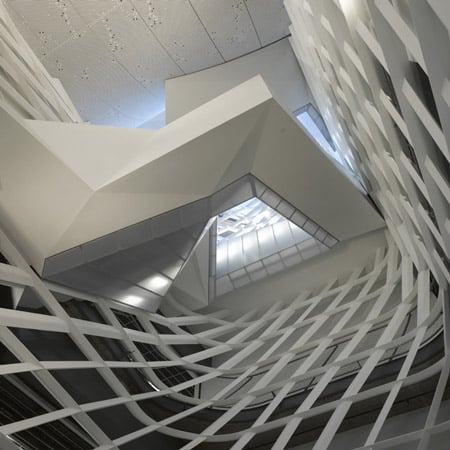
41 Cooper Square by Morphosis
Architectural photographer Roland Halbe has sent us his photographs of the recently-completed academic building for The Cooper Union in New York, designed by Thom Mayne of American practice Morphosis.
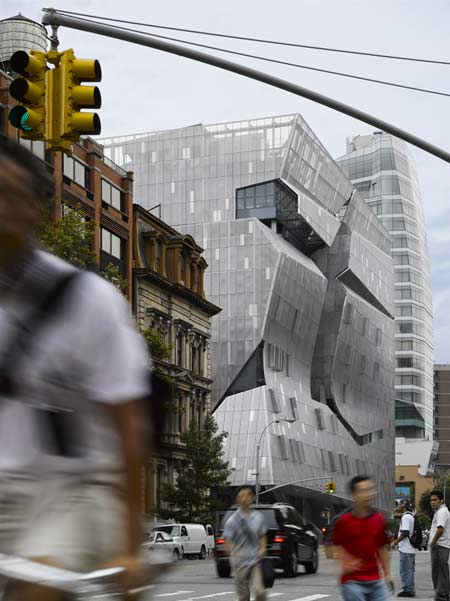
Located at 41 Cooper Square, the building houses the college's three schools teaching art, architecture and engineering.
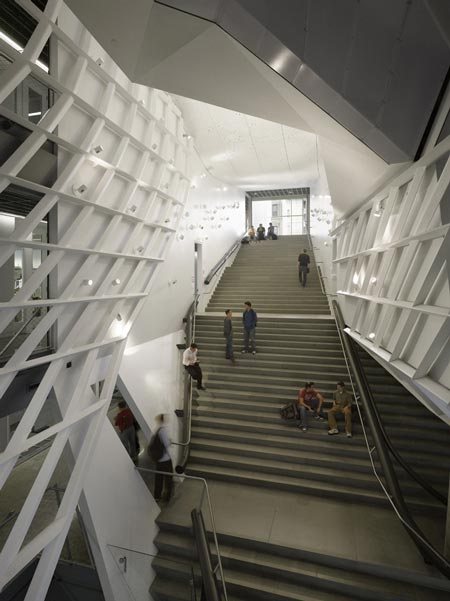
The building is wrapped in a perforated stainless steel skin.
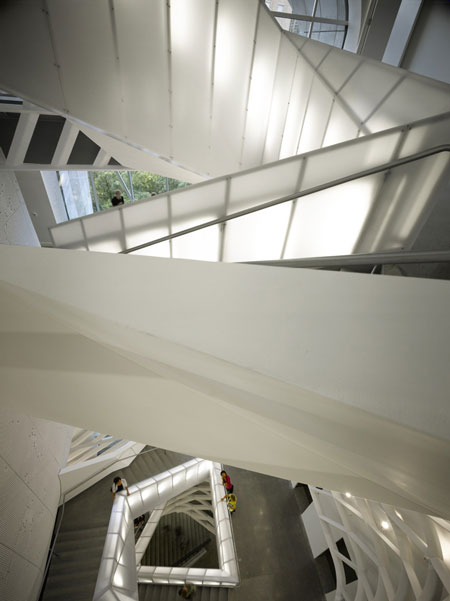
A six metre-wide staircase spirals around the central atrium, intended to provide meeting places and encourage dialogue between disciplines.
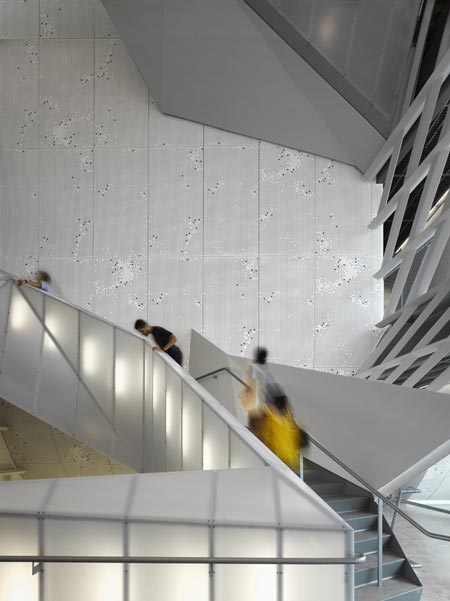
The main elevators stop only at the first, fifth and eighth floors to increase students' physical activity.
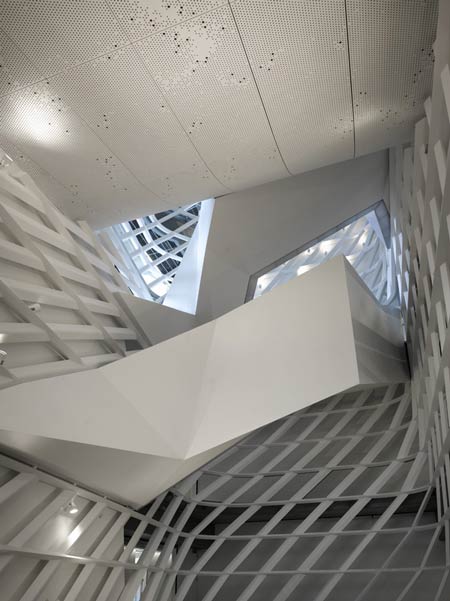
Here's some more information from the architects:
--
41 COOPER SQUARE
Architect’s Statement
Thom Mayne of Morphosis
41 Cooper Square, the new academic building for The Cooper Union, aspires to manifest the character, culture and vibrancy of both the 150 year-old institution and of the city in which it was founded. The institution remains committed to Peter Cooper’s radically optimistic intention to provide an education “as free as water and air” and has subsequently grown to become a renowned intellectual and cultural center for the City of New York. 41 Cooper Square aspires to reflect the institution’s stated goal to create an iconic building – one that reflects its values and aspirations as a center for advanced and innovative education in Art, Architecture and Engineering.
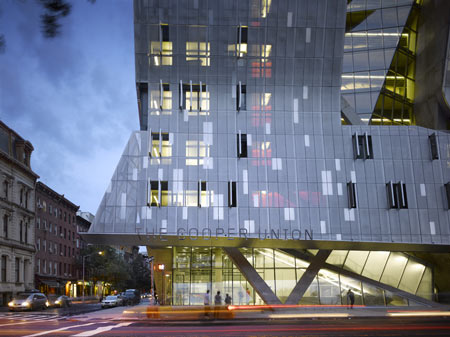
Internally, the building is conceived as a vehicle to foster collaboration and cross-disciplinary dialogue among the college’s three schools, previously housed in separate buildings. A vertical piazza—the central space for informal social, intellectual and creative exchange—forms the heart of the new academic building. An undulating lattice envelopes a 20-foot wide grand stair which ascends four stories from the ground level through the sky-lit central atrium, which itself reaches to the full height of the building. This vertical piazza is the social heart of the building, providing a place for impromptu and planned meetings, student gatherings, lectures, and for the intellectual debate that defines the academic environment.
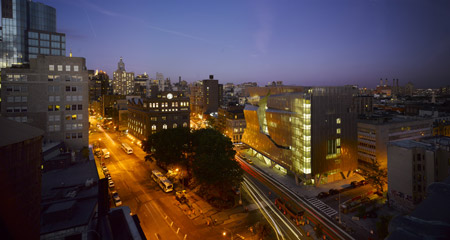
From the double-high entry lobby, the grand stair ascends four stories to terminate in a glazed double-high student lounge overlooking the city. On the fifth through ninth floors, sky lobbies and meeting places—including a student lounge, seminar rooms, lockers, and seating areas overlooking the cityscape—are organized around the central atrium. Sky bridges span the atrium to create connections between these informal spaces. Further reinforcement of the strategy to create a vibrant intellectual space is provided by the “skip-stop” circulation strategy which allows for both increased physical activity and for more impromptu meeting opportunities. The primary skip-stop elevators, which make stops at the first, fifth and eighth floors, encourage occupants to use the grand stairs and sky bridges. Secondary elevators stop at each floor, both for ADA compliance and for the practical tasks of moving materials, artworks, and equipment.
In the spirit of the institution’s dedication to free, open and accessible education, the building itself is symbolically open to the city. Visual transparencies and accessible public spaces connect the institution to the physical, social and cultural fabric of its urban context. At street level, the transparent facade invites the neighborhood to observe and to take part in the intensity of activity contained within. Many of the public functions - an exhibition gallery, board room and a two-hundred-seat auditorium - are easily accessible one level below grade.
The building reverberates with light, shadow and transparency via a high performance exterior double skin whose semi-transparent layer of perforated stainless steel wraps the building’s glazed envelope to provide critical interior environmental control, while also allowing for transparencies to reveal the creative activity occurring within. Responding to its urban context, the sculpted facade establishes a distinctive identity for Cooper Square. The building’s corner entry lifts up to draw people into the lobby in a deferential gesture towards the institution’s historic Foundation Building. The façade registers the iconic, curving profile of the central atrium as a glazed figure that appears to be carved out of the Third Avenue façade, connecting the creative and social heart of the building to the street.
Built to LEED Gold standards and likely to achieve a Platinum rating, 41 Cooper Square will be the first LEED-certified academic laboratory building in New York City. Advanced green building initiatives include:
An operable building skin made of perforated stainless steel panels offset from a glass and aluminum window wall. The panels reduce the impact of heat radiation during the summer and insulate interior spaces during the winter.
Radiant heating and cooling ceiling panels introduce innovative HVAC technology that will boost energy efficiency. This contributes to making the new building 40 percent more energy efficient than a standard building of its type.
A full-height atrium enables unique circulation for building occupants, improves the flow of air and provides increased interior day lighting.
Seventy-five percent of the building’s regularly occupied spaces are lit by natural daylight.
A green roof insulates the building, reduces city “heat island” effect, storm water runoff and pollutants; harvested water is reused.
A cogeneration plant provides additional power to the building, recovers waste heat and effectively cuts energy costs.
Flexible state-of-the-art laboratories, studios and classrooms are specifically designed to accommodate pedagogical objectives, as well as current and future research activities.
This aggregation of progressive green building initiatives combines with the building’s social spaces and urban connectivity to support Cooper Union in advancing its legacy of innovative ideas, cross-disciplinary knowledge, and creative practices well into the future.
41 Cooper Square Fact Sheet
The Cooper Union for the Advancement of Science and Art
The Project
The Cooper Union’ s new building at 41 Cooper Square—a technologically advanced academic facility—is located on the east side of Third Avenue between 6th and 7th Streets. In September 2009, 41 Cooper Square will house the college’s Albert Nerken School of Engineering and Faculty of Humanities and Social Sciences along with additional facilities for the School of Art and the Irwin S. Chanin School of Architecture. Designed by 2005 Pritzker Prize-winning architect Thom Mayne of Morphosis, the nine-story, 175,000 square foot, full-block building will replace more than 40 percent of the academic space at the college with reconfigurable, state-of-the-art classrooms, laboratories, studios and public spaces. Built with stringent sustainability goals, it is likely to achieve LEED platinum. 41 Cooper Square will be the first LEED certified academic laboratory building in New York City.
Building Facts
Construction start: November 13, 2006
Ribbon Cutting: September 15, 2009
Total space: 175,000 gross sq. ft., (nine stories plus two below grade; height: 135 ft.)
Laboratories: 39,000 sq. ft.
Studios: 10,000 sq. ft.
Classrooms: 15,400 sq. ft.
Student space: 5,080 sq. ft.
Public spaces (Frederick P. Rose Auditorium, Menschel Board Room, Jacques and Natasha Gelman Exhibition Foyer and Gallery): 8,800 sq. ft.
Outstanding Green Features
41 Cooper Square will be 40 percent more energy efficient than a standard building of its type due to exceptional use of green technologies:
Radiant heating and cooling ceiling panels introduce innovative HVAC technology to the United States that have proved to boost energy efficiency.
An operable building skin made of perforated stainless steel panels offset from a glass and aluminum window wall reduces the impact of heat radiation during the summer and insulates interior spaces during the winter.
A full-height atrium enables unique circulation for building occupants, improves the flow of air and provides increased interior day lighting.
A green roof insulates the building, reduces city “heat island” effect, stormwater runoff and pollutants; harvested water is reused.
A cogeneration plant provides additional power to the building, recovers waste heat and effectively cuts energy costs.
Flexible state-of-the-art laboratories, studios and classrooms are specifically designed with renewable, recycled and low emission materials that will accommodate pedagogical objectives, as well as current and future research activities.
Building Team
The Cooper Union’s building team is comprised of Thom Mayne/Morphosis with Gruzen Samton LLP architects; Jonathan Rose Companies, the owner’s representative; and F.J. Sciame Construction Co., Inc.
Project Credits
41 Cooper Square
New York, NY
2004-2009
Client: The Cooper Union for the Advancement of Science and Art
Architect: Morphosis
Thom Mayne, Principal / Design Director
Silvia Kuhle, Project Manager
Pavel Getov, Project Architect
Jean Oei, Job Captain/ Project Designer
Project Designers: Chandler Ahrens, Natalia Traverso Caruana, Go-Woon Seo
Project Team: Irena Bedenikovic, Salvador Hidalgo, Debbie Lin, Kristina Loock,
IT Co-ordinator: Marty Doscher
Project Assistants: Ben Damron, Graham Ferrier
Model Team: Reinhard Schmoelzer with Patrick Dunn-Baker, Charles Austin, Sean Anderson, Domenique Cheng, Soohyun Cheng, Eui Yeob Jeong, Amy Kwok, Shannon Loew, Brock Hinze, Hugo Martinez, Greg Neudorf
Associate Architect: Gruzen Samton, LLP
Peter Samton, Principal
Susan Drew, Project Manager
Project Team: Cathy Daskalakis, Joanne Fernando, Sari Mass, Ed Mayer, Mani Muttreja, Alfreda Radzicki, Stefanie Romanowski, Karlo Rosete, Suzanne Troiano, Robert Williams
Project Management: Jonathan Rose Companies, LLC
Jonathan Rose, Principal
Sarah Haga, Senior Project Manager
Sanjeevanee Vidwans, Project Manager
Construction Management: F.J. Sciame Construction Co., Inc
Frank Sciame, President
Steve Colletta, Project Executive
Robert DaRos, Project Manager
Landscape: Mathews Nielsen Landscape Architects, PC
Signe Nielsen, Principal
Jake Woland, Project Manager
Structural Engineer: John A. Martin Associates, Inc.
Chuck Whitaker, Principal
Kurt Clandening, Project Manager
Matt Timmers, Project Engineer
Goldstein Associates, PLLC
Keith Loo, Principal
Robert Franco, Project Manager
MEP: Mechanical Concepts:
IBE Consulting Engineers
Alan Locke, Principal
Peter Simmonds, Project Manager
Engineer of Record:
Syska Hennessy Group, Inc
Mark Yakren, Principal
Susan Kessler, Project Manager
Sergiu Pelau, Project Manager
Lab Consultant: Steve Rosenstein Associates, Inc
Steve Rosenstein, Principal
T.H. Chang, Principal
John Jaroz, Project Manager
Graphics:Pentagram Design
Abbott Miller, Principal
Laura Lee Vo, Project Manager
John Kudos, Project Designer
Performing Arts/Media: Auerbach Pollock Friedlander
Leonard Auerbach, President
Paul Garrity, Principal
Lighting Designer: Horton Lees Brogden Lighting Design, Inc
Teal Brogden, Principal
Stephen Lees, Principal
Justin Horvath, Project Manager
Acoustics Engineer: Newson Brown Acoustic, LLC
Michael Brown, Principal
Ian Boorer, Project Manager
IT/AV/Security: Syska Hennessy Group, Inc
Valentine Loh, Project Manager
Jeffrey Kirschner, Project Manager
IT: Barnes Wentworth
Herb Hauser, Principal
Kathleen Kotarsky, Project Manager
Civil Engineer: Langan Engineering and Environmental Services
DJ Hodson, P.E. Associate
Karen Taylor, Project Manager
Geotechnical Consultant: Mueser Rutledge Consulting Engineers
Alfred Brand, Partner
Walter Kaeck, Senior Associate
Fire Engineer: Arup Fire
Nathan Wittasek, Project Manager
Expeditor/Code: Berzak Schoen Consultants, Ltd
Irene Berzak, Principal
Vertical Transportation: Van Deusen & Associates
Rick Sayah, Associate
Façade Consultant: Gordon H. Smith Corporation
Gordon Smith, Principal
Mitchell Stein, Project Manager
Water Proofing Consultant: Henshell & Buccellato
Justin Henshell, Principal
Sustainable Design/LEED: Davis Langdon
Lisa Fay Matthiessen, Associate
Andrew Zumwalt-Hathaway
Penny Knopps
Environmental Design
Peer Reviewer: Atelier Ten
Nico Kienzl, Director
Co-Generation: Source One, Inc.
Mike Byrnes, Vice President
Source One
Michael Byrnes, Executive Vice-President
Commissioning: Synergy Engineering
Alec Strongin, Principal
Consulting Engineers: Rowan Williams Davies & Irwin, Inc
Peter Irwin, President
Derek Kelly, Project Manager
Cost: Davis Langdon
Ethan Burrows, Associate Principal